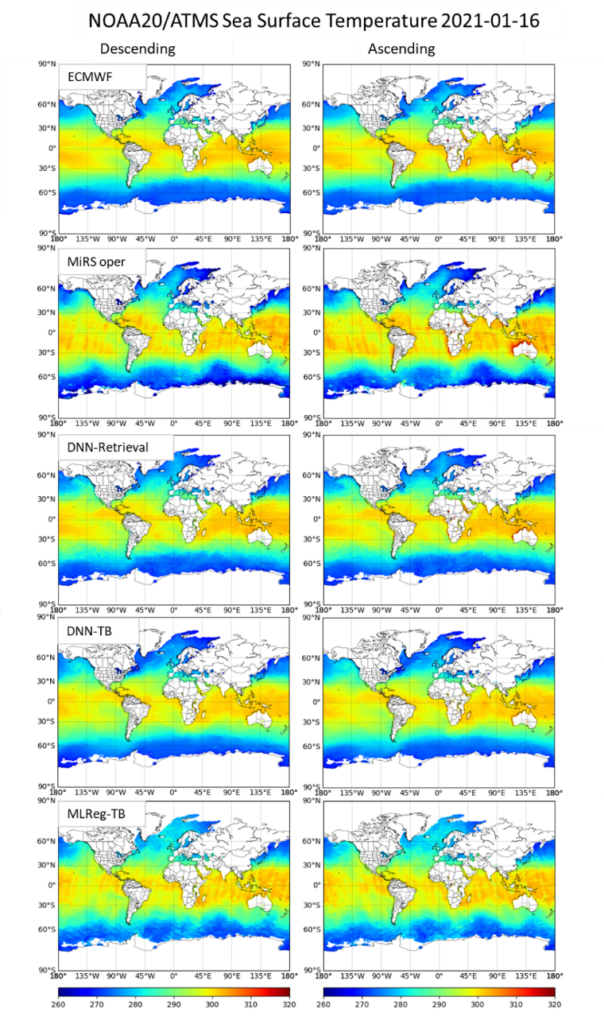The Microwave Integrated Retrieval System (MiRS) Science Team has published a paper in IEEE Journal on Selected Topics in Applied Earth Observations and Remote Sensing (JSTARS) titled “Improvement of MiRS Sea Surface Temperature Retrievals Using a Machine Learning Approach”. ESSIC/CISESS co-authors Chris Grassotti, Yan Zhou, and Yong-Keun Lee contributed to this paper alongside lead author Shuyan Liu from Colorado State University’s Cooperative Institute for Research in the Atmosphere and Mark Liu from NOAA/STAR.
In the study, various approaches were tested to improve the sea surface temperature (SST) retrievals from NOAA-20/ATMS measurements. These included a deep neural network (DNN) that used MiRS operational retrievals along with ATMS measurements and other metadata such as location and satellite observation zenith angle (DNN-Retrieval), a DNN that used satellite data alone (DNN-TB), and a multilinear regression that used satellite data (MLReg-TB). In all cases tested, the DNN-Retrieval approach yielded the best performance relative to ECMWF analyses, both in terms of overall statistics, but also in terms of lack of spatial artifacts and reduced scan angle dependence. The figure below shows results from one of the testing days.

The goal of the effort is not simply to improve the SST estimate, but to potentially incorporate the correction into the variational retrieval process itself within MiRS. For example, since the 1DVAR method simultaneously retrieves the atmospheric and surface state, optimizing the surface temperature specification may result in improved retrieval of the temperature and water vapor profiles.
Christopher Grassotti received a B.S. degree in earth and space science from the State University of New York at Stony Brook, Stony Brook, NY, USA, in 1982, tan M.S. degree in meteorology from the University of Wisconsin-Madison, Madison, WI, USA, in 1986, and an M.S. degree in viticulture and enology from AgroMontpellier, Montpellier, France, in 2007. From 1986 to 1991 and again from 1993 to 2005, he was a Research Associate, Senior Research Associate and Staff Scientist with Atmospheric and Environmental Research, Inc., Lexington, MA, USA. From 1991 to 1993, he was with the Atmospheric Environmental Service, Environment Canada, Dorval, QC, Canada. Since 2008, he has been with the National Oceanic and Atmospheric Administration, NOAA Center for Satellite Applications and Research, National Environmental Satellite, Data, and Information Service, College Park, MD, USA. He has been a Senior Faculty Specialist with ESSIC/CISESS since 2015.
Yan Zhou received the B.S, from Zhejiang University, China; the M.S. from the University of Georgia, U.S.; and the Ph.D. from the University of Maryland, U.S.; all in the major of Atmospheric Science. From 2015 to 2018, she worked for the CICS-MD Observing System Simulation Experiment (OSSE) Project at the Earth System Science Interdisciplinary Center (ESSIC), University of Maryland. Since 2019, she has worked at the ESSIC, in cooperation with NOAA/STAR for the Microwave Integrated Retrieval System (MiRS) project
Yong-Keun Lee is an Associate Research Scientist in the Earth System Science Interdisciplinary Center of the University of Maryland, College Park. He received a B.S. and a M.S. in Atmospheric Science from Seoul National University, and received a Ph.D. in Atmospheric Science from Texas A&M University. He is working on the NOAA Microwave Integrated Retrieval System (MiRS) which is the official operational satellite microwave retrieval algorithm currently being run on data from more than 7 different polar and non-polar orbiting satellites. His interests include remote sensing and data assimilation.






